An Investigation into Sexual Discrimination in Nursing Education
VerifiedAdded on 2023/06/04
|5
|1109
|273
Essay
AI Summary
This essay delves into the pervasive issue of sexual discrimination within nursing schools, examining its historical roots and contemporary manifestations. It highlights how gender stereotypes, rooted in societal expectations of men and women, contribute to both benevolent and hostile sexism within the field. The essay explores the challenges faced by male nurses, often subjected to verbal and non-verbal discrimination, and analyzes how the predominantly female faculty in nursing schools can perpetuate these biases. It underscores the potential negative impact on the healthcare workforce, affecting the quality of patient care. The essay concludes by emphasizing the detrimental effects of gender discrimination at all levels of nursing education and its implications for the broader healthcare system, citing key references to support its arguments.
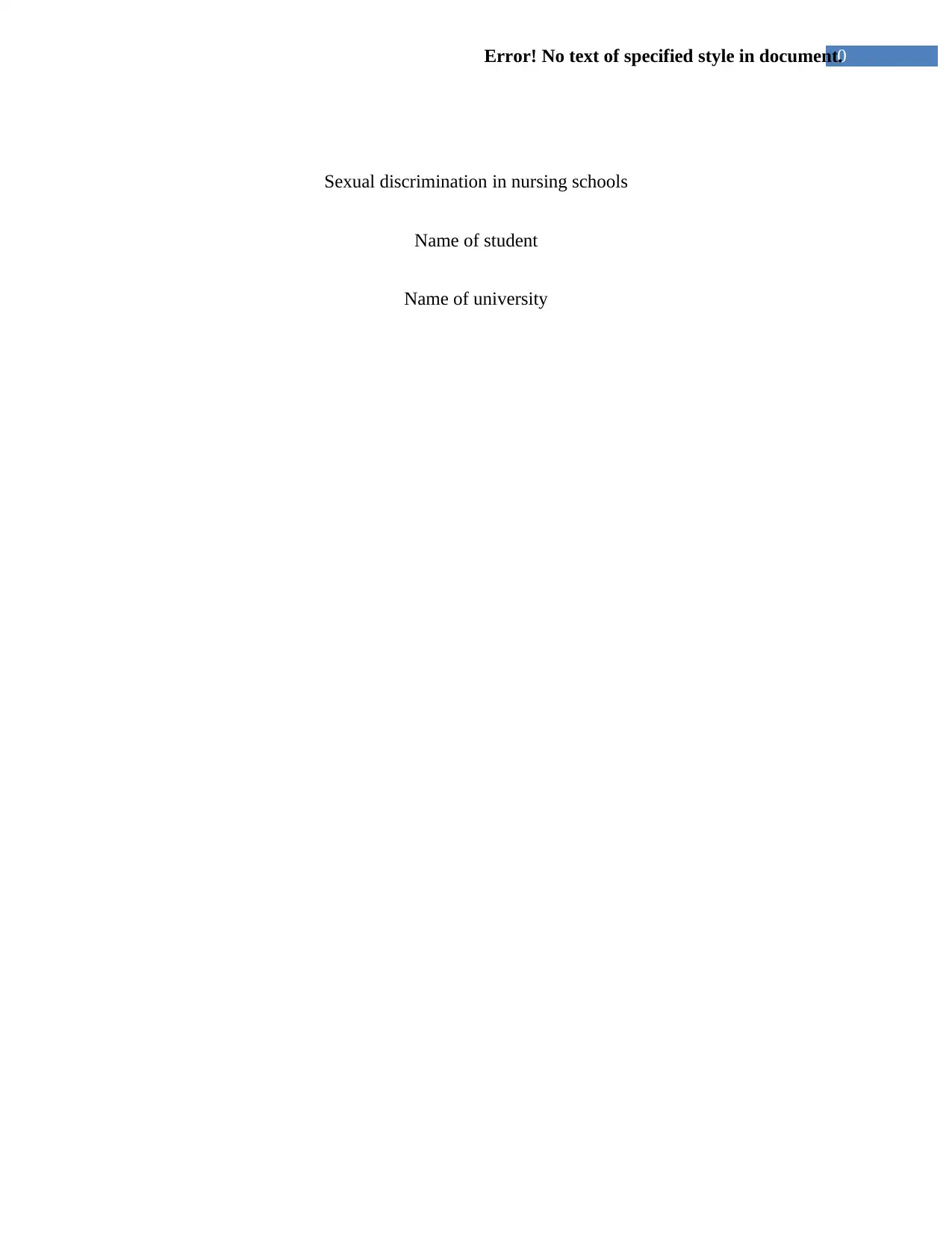
0Error! No text of specified style in document.
Sexual discrimination in nursing schools
Name of student
Name of university
Sexual discrimination in nursing schools
Name of student
Name of university
Paraphrase This Document
Need a fresh take? Get an instant paraphrase of this document with our AI Paraphraser
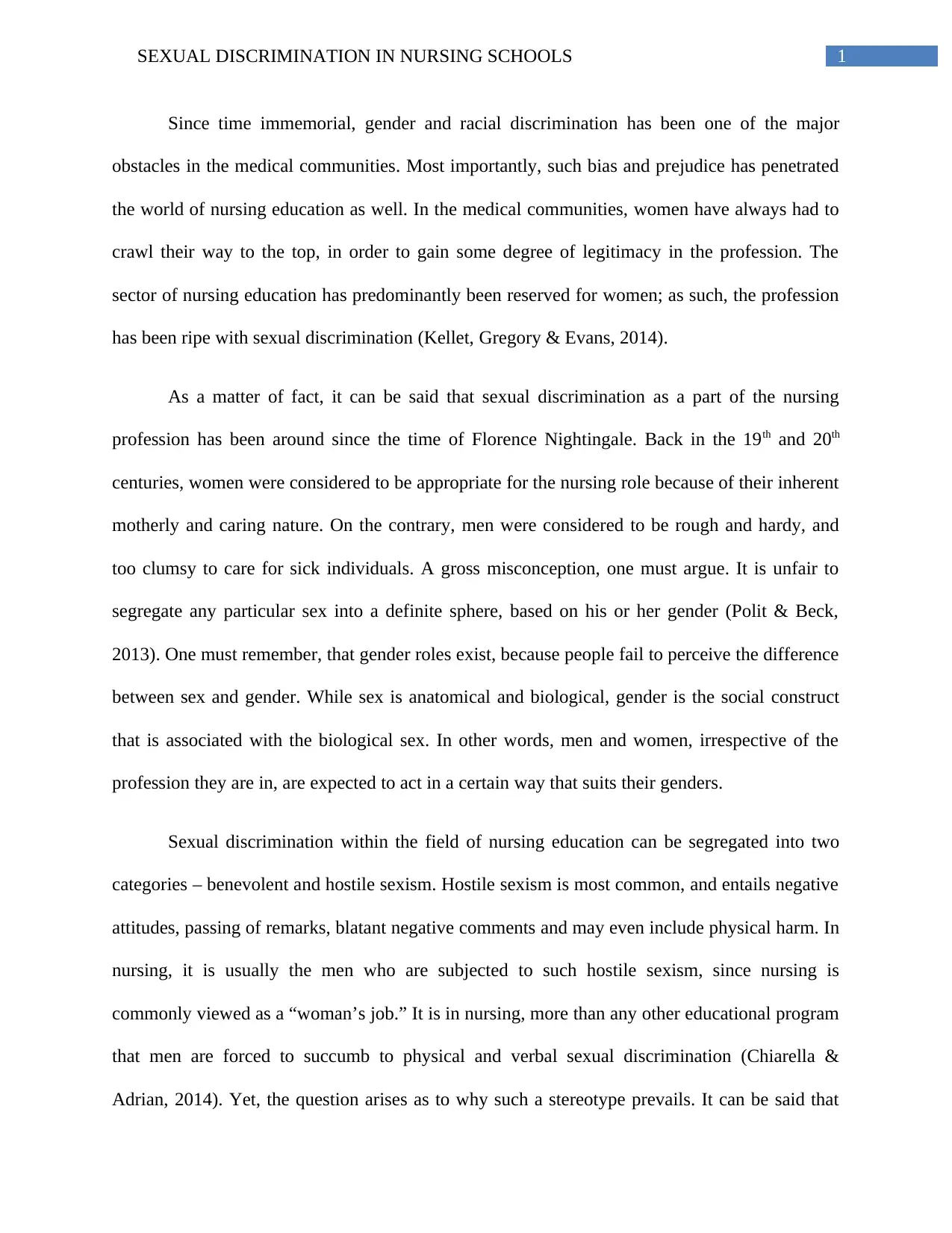
1SEXUAL DISCRIMINATION IN NURSING SCHOOLS
Since time immemorial, gender and racial discrimination has been one of the major
obstacles in the medical communities. Most importantly, such bias and prejudice has penetrated
the world of nursing education as well. In the medical communities, women have always had to
crawl their way to the top, in order to gain some degree of legitimacy in the profession. The
sector of nursing education has predominantly been reserved for women; as such, the profession
has been ripe with sexual discrimination (Kellet, Gregory & Evans, 2014).
As a matter of fact, it can be said that sexual discrimination as a part of the nursing
profession has been around since the time of Florence Nightingale. Back in the 19th and 20th
centuries, women were considered to be appropriate for the nursing role because of their inherent
motherly and caring nature. On the contrary, men were considered to be rough and hardy, and
too clumsy to care for sick individuals. A gross misconception, one must argue. It is unfair to
segregate any particular sex into a definite sphere, based on his or her gender (Polit & Beck,
2013). One must remember, that gender roles exist, because people fail to perceive the difference
between sex and gender. While sex is anatomical and biological, gender is the social construct
that is associated with the biological sex. In other words, men and women, irrespective of the
profession they are in, are expected to act in a certain way that suits their genders.
Sexual discrimination within the field of nursing education can be segregated into two
categories – benevolent and hostile sexism. Hostile sexism is most common, and entails negative
attitudes, passing of remarks, blatant negative comments and may even include physical harm. In
nursing, it is usually the men who are subjected to such hostile sexism, since nursing is
commonly viewed as a “woman’s job.” It is in nursing, more than any other educational program
that men are forced to succumb to physical and verbal sexual discrimination (Chiarella &
Adrian, 2014). Yet, the question arises as to why such a stereotype prevails. It can be said that
Since time immemorial, gender and racial discrimination has been one of the major
obstacles in the medical communities. Most importantly, such bias and prejudice has penetrated
the world of nursing education as well. In the medical communities, women have always had to
crawl their way to the top, in order to gain some degree of legitimacy in the profession. The
sector of nursing education has predominantly been reserved for women; as such, the profession
has been ripe with sexual discrimination (Kellet, Gregory & Evans, 2014).
As a matter of fact, it can be said that sexual discrimination as a part of the nursing
profession has been around since the time of Florence Nightingale. Back in the 19th and 20th
centuries, women were considered to be appropriate for the nursing role because of their inherent
motherly and caring nature. On the contrary, men were considered to be rough and hardy, and
too clumsy to care for sick individuals. A gross misconception, one must argue. It is unfair to
segregate any particular sex into a definite sphere, based on his or her gender (Polit & Beck,
2013). One must remember, that gender roles exist, because people fail to perceive the difference
between sex and gender. While sex is anatomical and biological, gender is the social construct
that is associated with the biological sex. In other words, men and women, irrespective of the
profession they are in, are expected to act in a certain way that suits their genders.
Sexual discrimination within the field of nursing education can be segregated into two
categories – benevolent and hostile sexism. Hostile sexism is most common, and entails negative
attitudes, passing of remarks, blatant negative comments and may even include physical harm. In
nursing, it is usually the men who are subjected to such hostile sexism, since nursing is
commonly viewed as a “woman’s job.” It is in nursing, more than any other educational program
that men are forced to succumb to physical and verbal sexual discrimination (Chiarella &
Adrian, 2014). Yet, the question arises as to why such a stereotype prevails. It can be said that
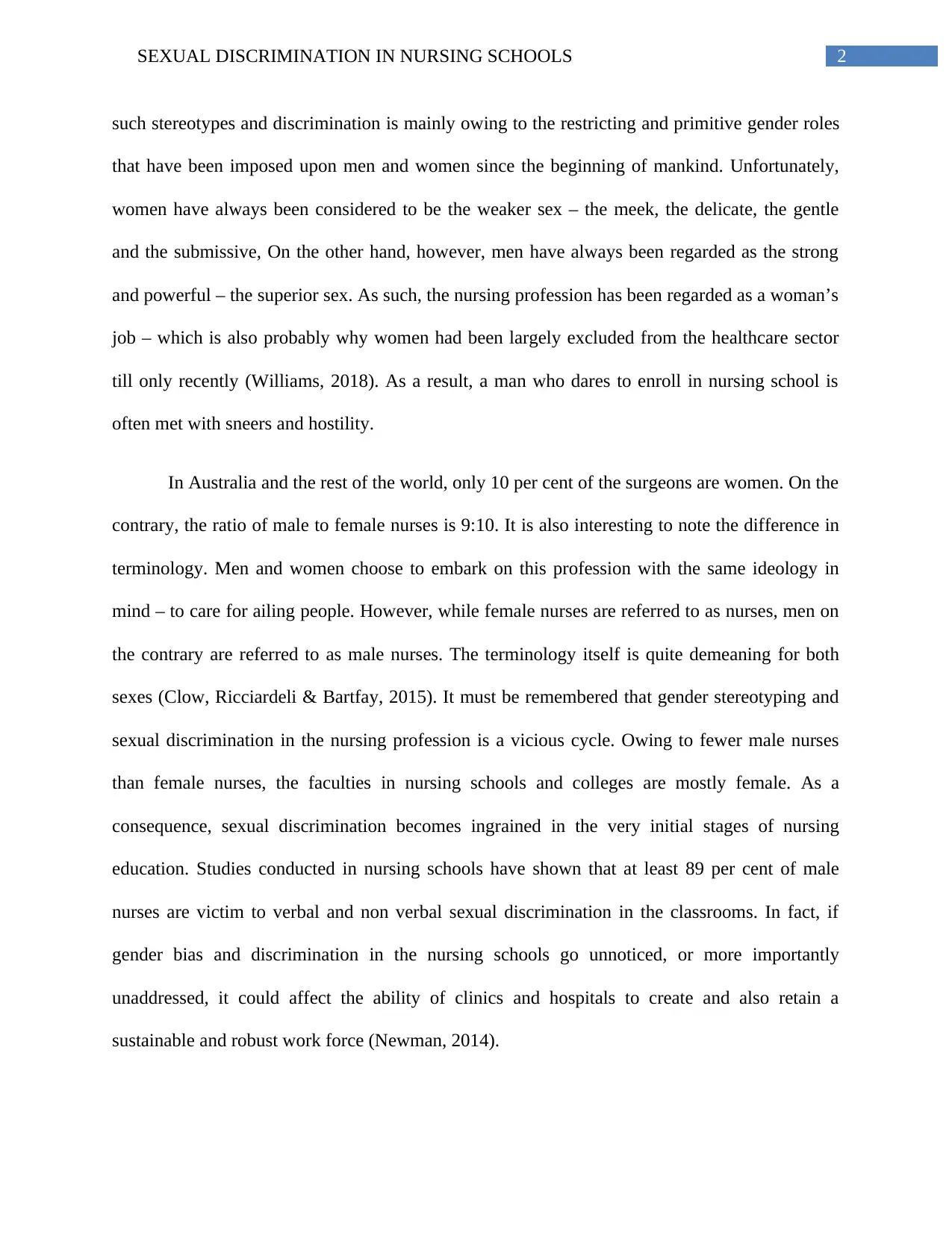
2SEXUAL DISCRIMINATION IN NURSING SCHOOLS
such stereotypes and discrimination is mainly owing to the restricting and primitive gender roles
that have been imposed upon men and women since the beginning of mankind. Unfortunately,
women have always been considered to be the weaker sex – the meek, the delicate, the gentle
and the submissive, On the other hand, however, men have always been regarded as the strong
and powerful – the superior sex. As such, the nursing profession has been regarded as a woman’s
job – which is also probably why women had been largely excluded from the healthcare sector
till only recently (Williams, 2018). As a result, a man who dares to enroll in nursing school is
often met with sneers and hostility.
In Australia and the rest of the world, only 10 per cent of the surgeons are women. On the
contrary, the ratio of male to female nurses is 9:10. It is also interesting to note the difference in
terminology. Men and women choose to embark on this profession with the same ideology in
mind – to care for ailing people. However, while female nurses are referred to as nurses, men on
the contrary are referred to as male nurses. The terminology itself is quite demeaning for both
sexes (Clow, Ricciardeli & Bartfay, 2015). It must be remembered that gender stereotyping and
sexual discrimination in the nursing profession is a vicious cycle. Owing to fewer male nurses
than female nurses, the faculties in nursing schools and colleges are mostly female. As a
consequence, sexual discrimination becomes ingrained in the very initial stages of nursing
education. Studies conducted in nursing schools have shown that at least 89 per cent of male
nurses are victim to verbal and non verbal sexual discrimination in the classrooms. In fact, if
gender bias and discrimination in the nursing schools go unnoticed, or more importantly
unaddressed, it could affect the ability of clinics and hospitals to create and also retain a
sustainable and robust work force (Newman, 2014).
such stereotypes and discrimination is mainly owing to the restricting and primitive gender roles
that have been imposed upon men and women since the beginning of mankind. Unfortunately,
women have always been considered to be the weaker sex – the meek, the delicate, the gentle
and the submissive, On the other hand, however, men have always been regarded as the strong
and powerful – the superior sex. As such, the nursing profession has been regarded as a woman’s
job – which is also probably why women had been largely excluded from the healthcare sector
till only recently (Williams, 2018). As a result, a man who dares to enroll in nursing school is
often met with sneers and hostility.
In Australia and the rest of the world, only 10 per cent of the surgeons are women. On the
contrary, the ratio of male to female nurses is 9:10. It is also interesting to note the difference in
terminology. Men and women choose to embark on this profession with the same ideology in
mind – to care for ailing people. However, while female nurses are referred to as nurses, men on
the contrary are referred to as male nurses. The terminology itself is quite demeaning for both
sexes (Clow, Ricciardeli & Bartfay, 2015). It must be remembered that gender stereotyping and
sexual discrimination in the nursing profession is a vicious cycle. Owing to fewer male nurses
than female nurses, the faculties in nursing schools and colleges are mostly female. As a
consequence, sexual discrimination becomes ingrained in the very initial stages of nursing
education. Studies conducted in nursing schools have shown that at least 89 per cent of male
nurses are victim to verbal and non verbal sexual discrimination in the classrooms. In fact, if
gender bias and discrimination in the nursing schools go unnoticed, or more importantly
unaddressed, it could affect the ability of clinics and hospitals to create and also retain a
sustainable and robust work force (Newman, 2014).
⊘ This is a preview!⊘
Do you want full access?
Subscribe today to unlock all pages.

Trusted by 1+ million students worldwide
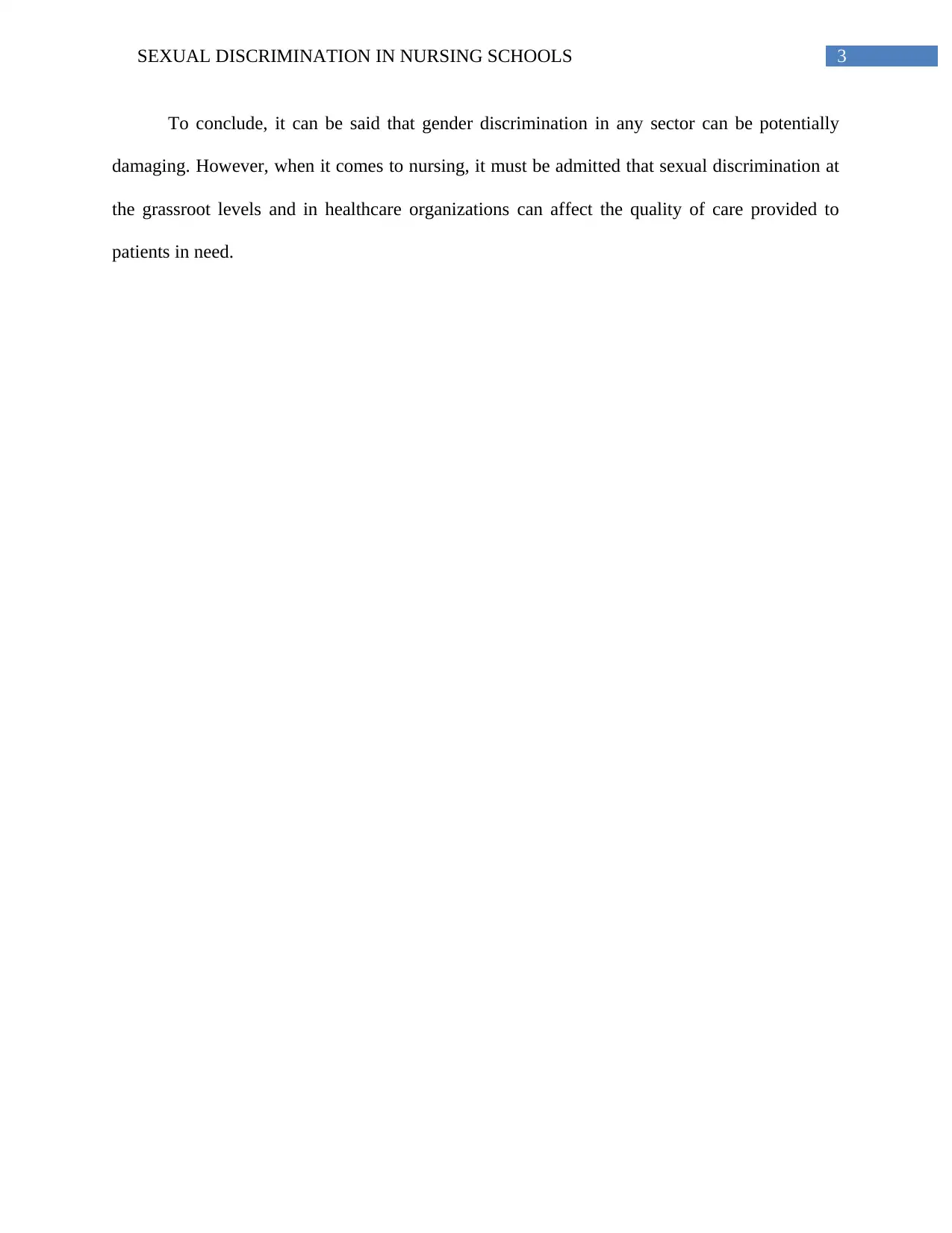
3SEXUAL DISCRIMINATION IN NURSING SCHOOLS
To conclude, it can be said that gender discrimination in any sector can be potentially
damaging. However, when it comes to nursing, it must be admitted that sexual discrimination at
the grassroot levels and in healthcare organizations can affect the quality of care provided to
patients in need.
To conclude, it can be said that gender discrimination in any sector can be potentially
damaging. However, when it comes to nursing, it must be admitted that sexual discrimination at
the grassroot levels and in healthcare organizations can affect the quality of care provided to
patients in need.
Paraphrase This Document
Need a fresh take? Get an instant paraphrase of this document with our AI Paraphraser
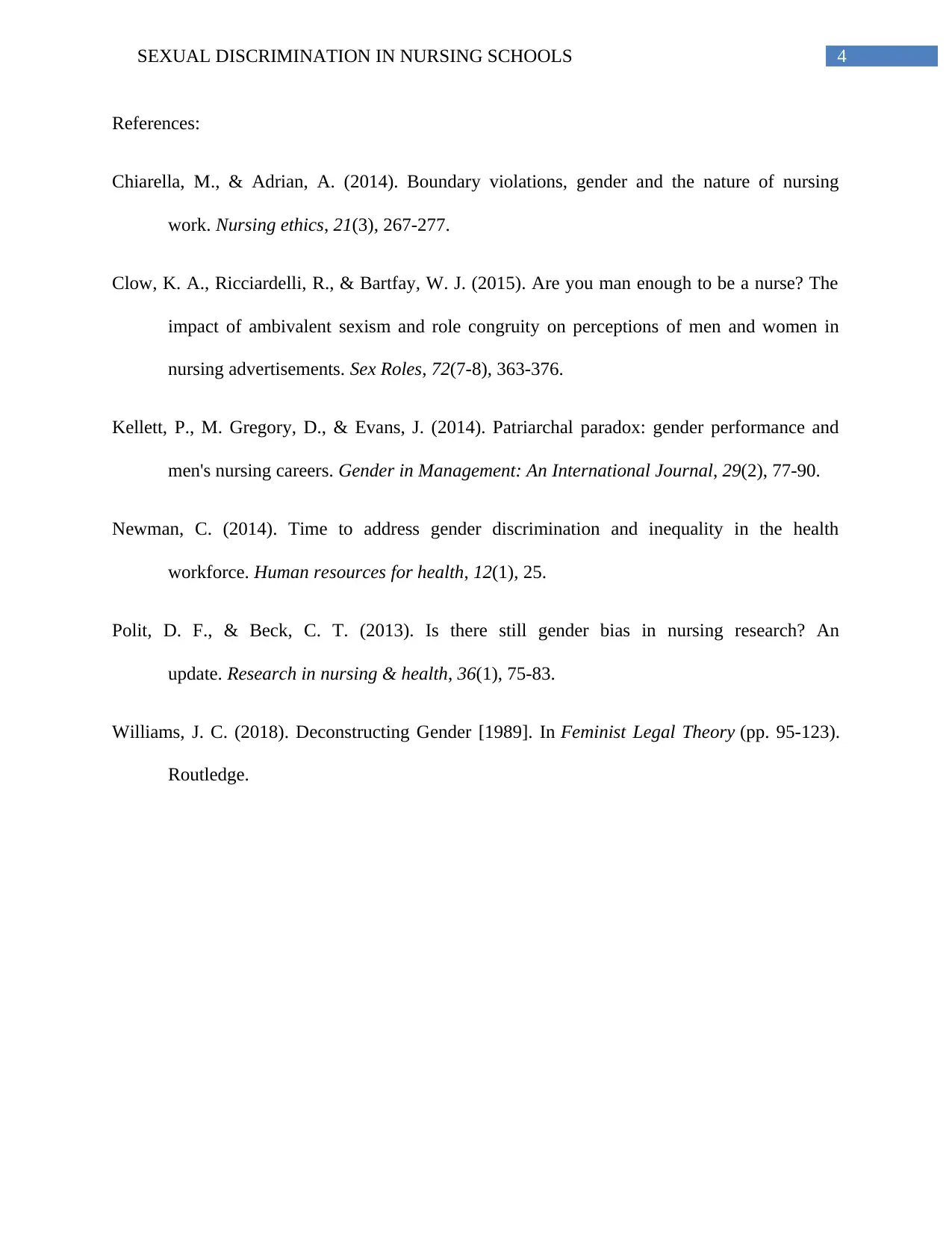
4SEXUAL DISCRIMINATION IN NURSING SCHOOLS
References:
Chiarella, M., & Adrian, A. (2014). Boundary violations, gender and the nature of nursing
work. Nursing ethics, 21(3), 267-277.
Clow, K. A., Ricciardelli, R., & Bartfay, W. J. (2015). Are you man enough to be a nurse? The
impact of ambivalent sexism and role congruity on perceptions of men and women in
nursing advertisements. Sex Roles, 72(7-8), 363-376.
Kellett, P., M. Gregory, D., & Evans, J. (2014). Patriarchal paradox: gender performance and
men's nursing careers. Gender in Management: An International Journal, 29(2), 77-90.
Newman, C. (2014). Time to address gender discrimination and inequality in the health
workforce. Human resources for health, 12(1), 25.
Polit, D. F., & Beck, C. T. (2013). Is there still gender bias in nursing research? An
update. Research in nursing & health, 36(1), 75-83.
Williams, J. C. (2018). Deconstructing Gender [1989]. In Feminist Legal Theory (pp. 95-123).
Routledge.
References:
Chiarella, M., & Adrian, A. (2014). Boundary violations, gender and the nature of nursing
work. Nursing ethics, 21(3), 267-277.
Clow, K. A., Ricciardelli, R., & Bartfay, W. J. (2015). Are you man enough to be a nurse? The
impact of ambivalent sexism and role congruity on perceptions of men and women in
nursing advertisements. Sex Roles, 72(7-8), 363-376.
Kellett, P., M. Gregory, D., & Evans, J. (2014). Patriarchal paradox: gender performance and
men's nursing careers. Gender in Management: An International Journal, 29(2), 77-90.
Newman, C. (2014). Time to address gender discrimination and inequality in the health
workforce. Human resources for health, 12(1), 25.
Polit, D. F., & Beck, C. T. (2013). Is there still gender bias in nursing research? An
update. Research in nursing & health, 36(1), 75-83.
Williams, J. C. (2018). Deconstructing Gender [1989]. In Feminist Legal Theory (pp. 95-123).
Routledge.
1 out of 5
Related Documents
Your All-in-One AI-Powered Toolkit for Academic Success.
+13062052269
info@desklib.com
Available 24*7 on WhatsApp / Email
![[object Object]](/_next/static/media/star-bottom.7253800d.svg)
Unlock your academic potential
Copyright © 2020–2025 A2Z Services. All Rights Reserved. Developed and managed by ZUCOL.

![Feminism and Sexuality Essay - [University Name] - [Semester]](/_next/image/?url=https%3A%2F%2Fdesklib.com%2Fmedia%2Fimages%2Fkv%2F2a55f341ece04271989c314551651523.jpg&w=256&q=75)



